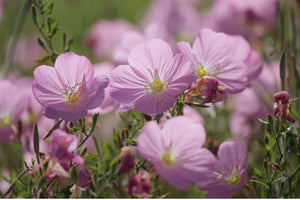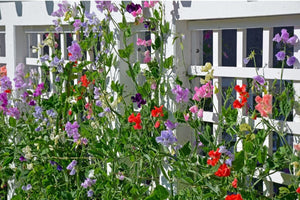Our Favorite Herbs to Plant in Fall for a Flavorful Harvest
Did you know? Fall is one of the best times to start herbs! The warm soil encourages germination, and the milder temperatures of Autumn are perfect for heat-sensitive plants. No matter where you grow, you can plant these herbs in your fall garden or containers to enjoy a delicious harvest before the cold weather hits!

We love growing our own herbs to always have a fresh supply for any recipe. Planting herbs in the fall for an outdoor or indoor herb garden will ensure you always have the freshest, most flavorful herbs. And if you’re looking for a simple way to get started, try our herb garden starter kit.
9 Herbs to Plant in Fall
Chives

Chives are one of our favorite herbs to grow because they can be used in many dishes. Both regular and garlic chives add flavor to herb butter, sour cream, and vinegar. Chives can be divided and brought indoors to overwinter. When left outside, they will start regrowing again when the temperatures warm up in spring. Learn more about growing chives.
Cilantro

There is no substitute for the unique flavor of cilantro. This fast-growing herb is an excellent choice for a fall garden. Because it so easily bolts and goes to seed when temperatures rise about 85ºF, growing cilantro in the fall will give you a more reliable harvest. Cilantro prefers cool temperatures and can even grow in partial shade. Read more about growing cilantro.
Dill

Not only can dill be used for a variety of pickling and preserving recipes, but it also makes an excellent holding piece for floral arrangements. Planting dill in the fall will ensure you have this necessary ingredient for fall crafts and recipes. Dill is also a host plant for butterflies, and they’ll appreciate this vital plant in your garden. Learn how to grow dill from seed.
Fennel

Plant fennel in late summer, and the cooler fall temperatures will help keep it from bolting. Since it grows a deep tap root, sowing fennel seeds directly into the garden is best. Once it is established, fennel can tolerate a light frost. In milder climates, new leaves and stems will sprout from the base in spring.
Oregano

Oregano is a delicious herb for fall and winter recipes. It pairs perfectly with all those ripe tomatoes. As a perennial herb, it will come back in the spring after going dormant in the winter. Learn more about growing oregano.
Parsley

Parsley seeds germinate well in warm soil. But once it has sprouted and is growing, parsley can thrive in the cooler fall temperatures. Parsley is a biennial, so you can harvest parsley all winter if temperatures are moderate and then replant in spring. Once temperatures are consistently below 40ºF, parsley will start to flower and go to seed. Read more about starting parsley from seed.
Rosemary

Rosemary is a perennial herb that makes a beautiful holiday gift for gardening friends or home chefs. The aroma of rosemary has been shown to reduce stress.
Rosemary grows slowly at first, so planting in the fall and giving it extra time to grow will result in a bigger plant in the summer. Cold stratification and winter sowing are also effective ways to get rosemary seeds started. Learn more about growing rosemary.
Sage

Sage is a vital ingredient for a fall harvest meal. From roasted turkeys to fragrant stuffing, you’ll enjoy having fresh sage on hand. This hardy perennial can be started indoors or directly sown.
Thyme

Thyme is an excellent container herb and can be started any time of year. This perennial herb is easy to grow and can be used fresh and dried. Thyme is also a beneficial companion plant for tomatoes and cabbage. It can also be grown to encourage pollinators, as bees and butterflies are drawn to thyme flowers. Read more about thyme and how to grow it.
Fall Herb Seed Starting Tips
Plant seeds directly when outside temperatures are moderate.
Check the seed packet or our Planter’s Library for specific seed germination tips.
Keep seeds moist for successful germination.
Herb seeds can be started indoors and then transplanted outdoors.
Tips for Planting Fall Herbs
Plan out your seed starting schedule.
Established herbs can survive cooler temperatures. Give your herb plants enough time to become established before the first fall frost.
Know your gardening zone.
What you can plant and when will be determined by your growing zone. Some zones are moderate enough that herbs will grow through the winter. In other locations, you will need to plant herbs in containers and bring them inside to overwinter.
Choose your location.
Many herbs need full sun. Longer fall shadows may shade more parts of your garden than in summer.
Prepare your soil.
Herbs generally don’t need extra fertilizer. Starting with fertile garden soil will get your herbs off to a successful start.
Why Planting Herbs in Fall Makes Sense
There are several reasons why planting herbs in late summer and early fall is a smart gardening method.
Just like a fall garden is an excellent way to grow cool-weather vegetables, planting fall herbs takes advantage of cooler temperatures resulting in less plant stress. Some herbs, such as cilantro and fennel, will go to seed in hot summer temperatures. Planting these and other herbs in the fall will keep them happily growing until freezing temperatures hit.
Also, some herbs that die back in the winter will start growing again when the weather warms up in the spring. You’ll have a head start on your summer herb harvest by planting in the fall.
Here in the Midwest, we can have some brutal temperatures in January and February. But in many parts of the country, such as Texas and Florida, moderate winters mean your herbs will continue growing with minimal effort. Learn more about overwintering your vegetable and herb gardens.
Growing your own fresh herbs is so rewarding. Start planting your fall herbs now so you can enjoy the fresh homegrown flavor!
Popular Posts
-

Showy Evening Primrose Flowers: Easy to Grow, Harvest, and Use
-

How to Grow Sweet Peas - The Ultimate Cool Weather Flower






Leave a comment